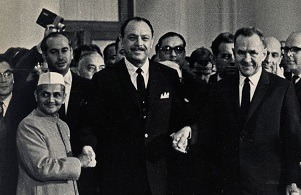The Soviet Union, which had remained neutral when India and Pakistan went to war in September 1965, played the broker afterwards at Tashkent. The Soviet Government formally announced on December 8 that the Indian Prime Minister Lal Bahadur Shastri and the Pakistani President Muhammad Ayub Khan would meet at Tashkent on January 4, 1966. The Tashkent Conference lasted from January 4 to January 10. Largely as due to the efforts of Soviet Premier Kosygin, India and Pakistan signed a declaration that is known as the Tashkent Declaration.
The significant clauses of this agreement were:
- The Prime Minister of India and the President of Pakistan agree to make all efforts to establish good relations between India and Pakistan in accordance with the United Nations Charter. They affirm to renounce the use of force in the settlement of their disputes.
- The President of Pakistan and the Indian Prime Minister agree to withdraw, no later than February 25, 1966, all armed personnel to the position held before August 5, 1964.
- Both India and Pakistan agree to follow the principle of non-interference in their affairs and will discourage the use of any propaganda against each other.
- Both the countries also agree to reopen normal diplomatic functioning and to return of the High Commissioners of both the countries to their posts.
- Measures towards the restoration of economic and trade relations, communications, as well as cultural exchanges between the two countries were to be taken. Measures were to be taken to implement the existing agreements between Pakistan and India.
- Prisoners of war would be repatriated.
- Discussions would continue relating to the problem of refugees and eviction of illegal immigrants. Both sides will create conditions that will prevent the exodus of the people.
The President of Pakistan and the Indian Prime Minister agreed that both sides would continue to meet at the highest and other levels on matters of direct concern to both the countries. Both the sides recognized the need to set up joint Indo-Pakistan bodies, which would report to their governments in order to decide what further steps need to be taken. In accordance to the Tashkent Declaration, talks at the ministerial level were held on March 1 and 2, 1966. Despite the fact that these talks were unsuccessful, diplomatic exchange continued throughout the spring and summer. No result was achieved out of these talks, as there was a difference of opinion over the Kashmir issue.
Euphoria had built up during the 1965 war, which had led to the development of a public perception that Pakistan was going to win the war. News of the Tashkent Declaration shocked the people who were expecting something quite different. Things further worsened as Ayub Khan refused to comment and went into seclusion instead of taking the people into confidence over the reasons for signing the agreement. Demonstrations and rioting erupted at various places throughout the country. In order to dispel the anger and misgiving of the people, Ayub Khan decided to lay the matter before the people by addressing the nation on January 14.
It was the difference over Tashkent Declaration, which eventually led to the removal of Z. A. Bhutto from Ayub’s government, who later on launched his own party, called the Pakistan People’s Party.
Despite the fact that Ayub Khan was able to satisfy the misgiving of the people, there is no doubt that the Tashkent Declaration greatly damaged the image of Ayub Khan, and became one of the many factors that led to his downfall.
This article was last updated on Sunday, June 01, 2003[/fusion_text][/fusion_builder_column][/fusion_builder_row][/fusion_builder_container]






